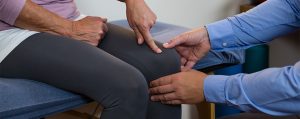What Does Physical Therapy Look Like After A Stroke?
During one year in the United States, 795,000 people will have a stroke, or cerebrovascular accident (CVA)1. Of these, 610,000 will be first-time CVA1. This is obviously a large number, and chances are you know someone who has experienced, or will know someone who will experience a CVA.
How Exercise Can Boost Mental Health During Postpartum Depression
Exercise is known to have many physical benefits, including improved quality of life and reduced risk of chronic disease. As most individuals know, exercise helps improve physical health and has mental health benefits. Exercise can help by improving self-esteem and cognitive function, as well as reducing mental health concerns, including anxiety, depression, and negative mood. Exercise plays a role in mental health care by increasing blood circulation to the brain leading to a reduced reactive response to stressors. Despite the most recent research, exercise is often underutilized as an intervention regarding mental health, specifically in the postpartum population.
Stop, Drop And Roll: Should You Be Using A Foam Roller?
Foam rollers have become a staple in many physical therapy clinics and gyms. If you have never seen one before, it is a 3 ft x 6-inch foam cylinder that can be used for stretching and massaging muscles during the recovery process as well as pre and post-workout. While it is a simple looking tool, there are many ways to use it. Many people swear by the benefits of foam rolling stating that it helps them feel more limber and reduce pain. These claims certainly sound good, but what does rolling out your muscles actually do and could it be a beneficial tool for you?
A Simple Exercise Routine To Try When You Need A Little Boost of Positivity
Feeling stuck in a rut? Or like you just want to relax on the couch and order food? Believe it or not, a little bit of exercise can go a long way in shifting our thoughts and feelings in a positive way. Below are a few suggestions for when you need a little boost of happiness in your day.
Is It Safe To Workout With Shoulder Pain?
Working out in pain can generate some fear and anxiety in many people. You have heard that exercise can help with pain, but the thought of putting yourself through more pain, especially if it’s been hanging around for a long time, can be daunting. As physical therapists, we see this fear and anxiety daily, but we have the tools to help guide our patients through this process, and the results show a stark contrast from the beginning to the end of their care.
Struggling With Incontinence? Here Are 3 Exercises You Should Try, According To A Pelvic Health PT
Incontinence, or the lack of voluntary control over urination and defecation, can be life-altering. It can come in six types: insensible, stress, urgency, mixed, nocturnal enuresis, and overflow. Depending on the type of incontinence, your therapy will be specific to you. However, below, you will find the most common pelvic floor retraining exercises to help get you started. For more personalized care, please reach out to a physical therapist (PT) near you.
A Lower Body Workout That’s Fit for the Office
We’ve all had those days where we hit snooze on our alarm clock or are too tired after work to make it to the gym. The bed is just too cozy, or binge-watching your favorite show is more appealing than your next workout. What if there was a way to work out during the workday and still do some work out on the days getting to the gym just isn’t happening? Well, you’re in luck; look at these five leg exercises that are fit for the office.
Is Your Ankle Mobility Holding Back Your Running
Runners are known to push into pain in pursuit of their goals. Setting a new 5k PR or training for a marathon involves an unavoidable degree of discomfort. However, some nagging aches and pains are our body’s way of telling us something needs fixing. Whether you are a rearfoot or forefoot runner, a large amount of force goes through your ankle when you run1. While knee or ankle pain could be normal delayed-onset muscle soreness (DOMS) from running, it could also be related to ankle mobility2.
